Gem Silica
A bluish green to greenish blue chalcedony that obtains its color from copper.
Author: Hobart M. King, PhD, GIA Graduate Gemologist
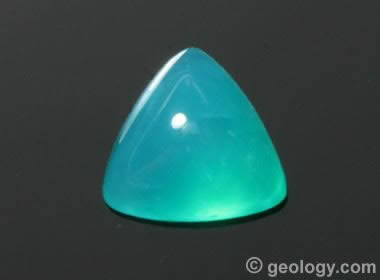
Gem Silica Cabochon: A gemmy, vivid blue cabochon cut from natural, translucent gem silica from the Inspiration Mine, Gila County, Arizona. It is a 1.59 carat trillion measuring about 7.55 x 7.41 x 4.88 millimeters.
What is Gem Silica?
Gem silica is a bluish green to greenish blue variety of chalcedony that receives its vivid color from the presence of copper. It is often known as "chrysocolla chalcedony" or "gem silica chrysocolla."
Gem silica is the most valuable variety of chalcedony, with quality cut gemstones selling for over $100 per carat. The best specimens have a pleasing blue color with strong saturation, a uniform translucence, and and a lack of inclusions.
Even though gem silica is one of the most beautiful blue gemstones, most people have never heard of it. That is because it is a very rare gem. It is seldom seen in jewelry and is used mainly by a small number of high-end jewelry designers.
Table of Contents
 What is Gem Silica? What is Gem Silica? Geology of Gem Silica Geology of Gem Silica Gem Silica's Names and Color Gem Silica's Names and Color Gem and Jewelry Market Gem and Jewelry Market Treatments Treatments |
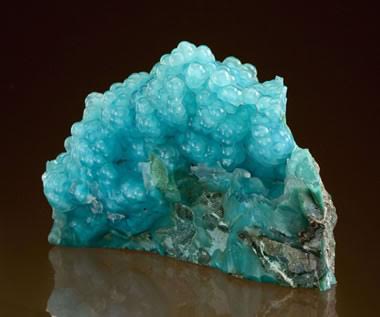
Botryoidal Gem Silica: A beautiful specimen of gem silica in a turquoise blue color, exhibiting the botryoidal habit that is typical of chalcedony. This specimen is approximately 8 x 5.5 x 3.5 centimeters in size. Specimen and photo by Arkenstone / www.iRocks.com.
Geology of Gem Silica
Only a few locations have produced noteworthy amounts of gem silica. Most of these locations have been productive for only a few years before being worked out.
Gem silica is always associated with copper deposits. It is a secondary mineral that forms as cavity linings and fracture fillings in the rocks above and adjacent to copper deposits. It is even known to occur as a mineral lining in geodes (see photo on this page). Its occurrence, habits, and deposit geometries are like any other type of chalcedony. Commonly associated minerals include quartz, chalcedony, chrysocolla, and malachite. Deposits are usually small in size and volume. It is a material produced by the gram rather than by the ton.
The Miami-Inspiration Mine in Arizona is the best recent source of high-quality gem silica. The Keystone Copper Mine in Arizona produced notable amounts of gem silica in the early 1900s. Gem silica has been produced occasionally and in limited amounts from locations in New Mexico, Mexico, Peru, Taiwan, and the Philippines.
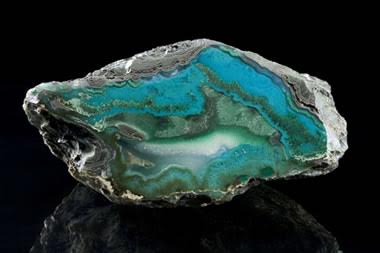
Gem Silica Nodule: A nodule composed of gem silica, quartz chalcedony, chrysocolla, and malachite. From the Inspiration Mine, Gila County, Arizona. This specimen is approximately 13.5 x 9.6 x 6.3 centimeters in size. Specimen and photo by Arkenstone / www.iRocks.com.

Stalactitic Gem Silica: A geode with stalactites of gem silica (inverted). From the Inspiration Mine, Gila County, Arizona. Specimen and photo by Arkenstone / www.iRocks.com.
Gem Silica's Names and Color
The names "chrysocolla chalcedony" and "gem silica chrysocolla" are used because the green to blue color of gem silica is related to chrysocolla. Some references state that the color is caused by minute inclusions of chrysocolla within the silica. [1] [2] [3] Others attribute the color to "the same copper salts that give chrysocolla its color." [3] [4]
The name "chrysocolla chalcedony" is appropriate if the person using the name knows that their material contains chrysocolla. The name "gem silica chrysocolla" is a misnomer because chrysocolla is not the primary constituent. "Gem silica" is the most appropriate name.
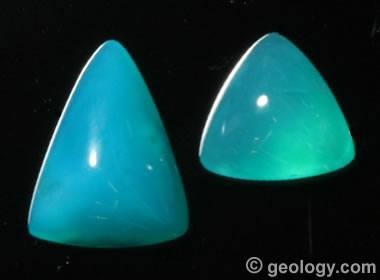
Gem Silica Cabochons: Two gem silica cabochons cut from material produced at the Inspiration Mine, Gila County, Arizona.
Gem and Jewelry Market
As a variety of chalcedony, gem silica has a Mohs hardness of 7 and is durable enough for use in almost any jewelry design. Yet, gem silica is rarely seen in jewelry. The gem is rare, costly, and the supply is limited.
You will probably never see it in mall jewelry stores. The supply is so limited and unpredictable that a large retail chain would be unable to acquire thousands of calibrated cabochons to launch a new product line, then count on more being available if the product line is successful.
If beautiful gem silica jewelry was featured in mall jewelry stores, it might sell slowly because of its high cost and because the average jewelry buyer has never heard of it.
The most likely place to find gem silica in jewelry is in a high-end jewelry store that sells unique one-of-a-kind items. Customers who shop there are the most likely buyers of such rare, expensive, and interesting items. Gem silica is a material for designers and artists rather than mass market manufacturers.
A significant percentage of the gem silica sold as cut stones today is purchased by gem collectors, investors, and speculators. They are a major market for rare, costly, and unusual gems of all kinds.
| Gem Silica Information |
| [1] Andy Shen, Eric Fritz, Dino DeGhionno and Shane McClure, (2006). Identification of Dyed Chrysocolla Chalcedony. Article in the Fall 2006 issue of Gems and Gemology, published by the Gemological Institute of America. [2] Colored Stones, Chapter 20, Quartz and Chalcedony, (2002). Textbook that accompanies the Colored Stones eLearning course offered by the Gemological Institute of America. [3] Gem Reference Guide for the GIA Colored Stones Course, (1995). Gemological Institute of America. [4] AJSGems.com (last accessed February 2018). Gem Silica or Chrysocolla Chalcedony. Article published on the AJS Gems website. [5] GemSelect.com (last accessed February 2018). Gem Silica. Article published on the GemSelect.com website. |
Treatments
Most valuable gem materials have their impostors, and gem silica is not an exception. Chalcedony is a porous material and easily absorbs liquids. The color of gem silica can be temporarily enhanced by placing it in water. Absorbed water enriches the gem's color.
Clear and milky chalcedony is easily dyed. Chalcedony colored by this method should not be sold as "gem silica," as that would be a misnomer, but some merchants have done it. Buy gem silica from a dealer who you believe is trustworthy and knowledgeable.
| More Gemstones |
 |
Birthstones |
 |
Diamond |
 |
Blue Gemstones |
 |
100+ Gems |
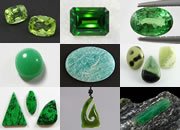 |
Green Gemstones |
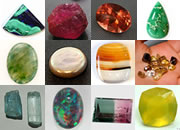 |
Mined in America |
 |
Ruby and Sapphire |
 |
Tumbled Stones |

Find Other Topics on Geology.com:

|

| ||

|

| ||

|

| ||

|

|
